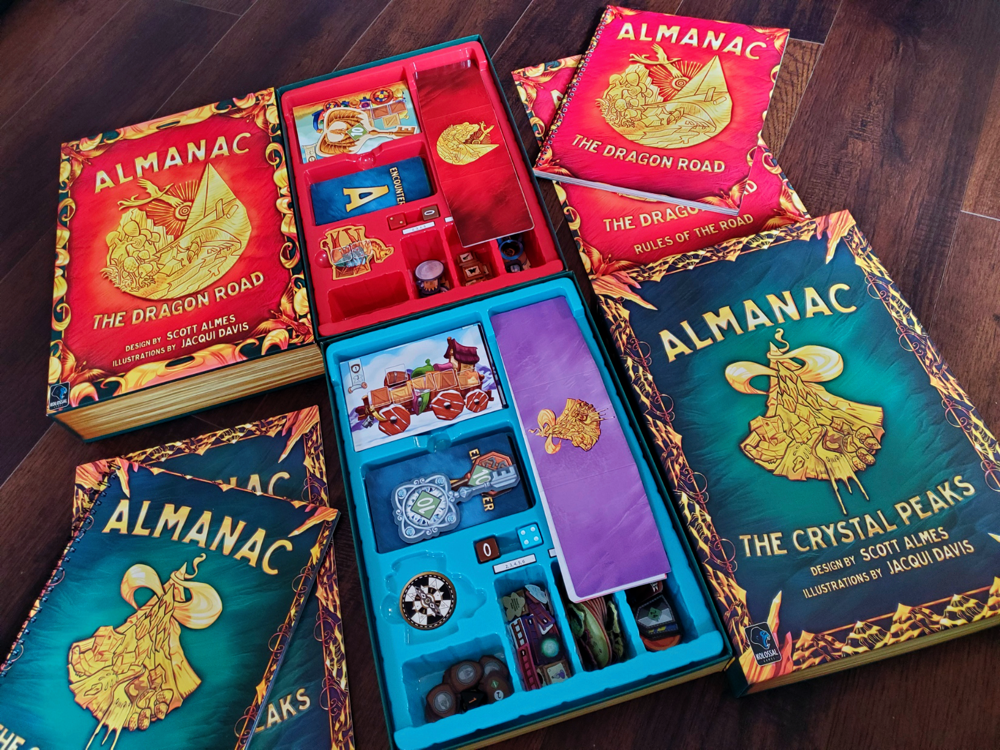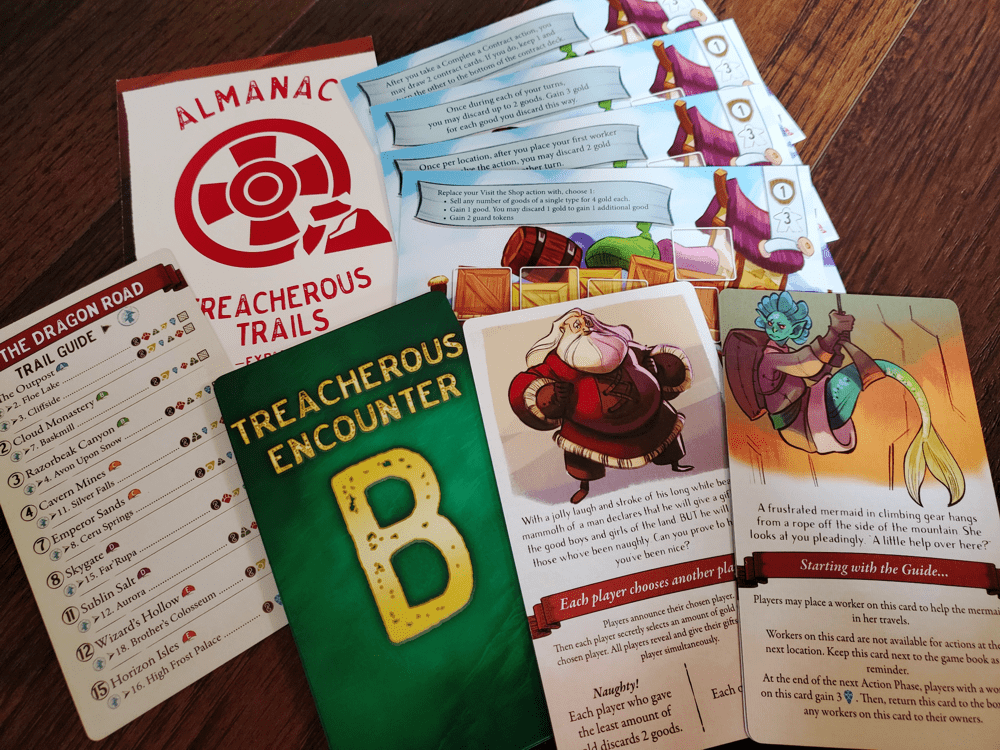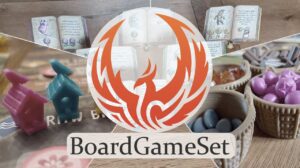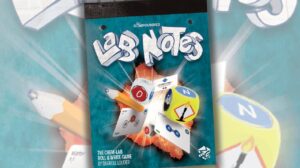Disclosure: Meeple Mountain received a free copy of this product in exchange for an honest, unbiased review. This review is not intended to be an endorsement.
One of the best reading experiences I’ve had with my family was the entire corpus of Lemony Snicket’s A Series of Unfortunate Events. We read all thirteen books aloud together over the course of two years. We dove headlong into the Netflix series (which is an excellent adaptation, by the way) as a treat after the arduous journey.
One of the strange qualities of the Series is in the fact that the first half dozen books or so all feature the exact same plot. Don’t get me wrong, every book bears its own unique alliterative title, disturbing setting, and odd characters, but they all share one repetitive plot. I’ve not attempted a chapter-by-chapter breakdown, but I think some of the twists could be traced almost to the page, so formulaic is the map.
And yet, I love every word. I love Lemony Snicket’s dry and sarcastic narrative tone, his occasional grammatical lesson, and his general disregard for the fourth wall. I love the way I see the denouement coming every time and I keep coming back for more. Of course, when the formula eventually breaks, the entire series enjoys an invigorating thrust across several more books toward the finish. But what struck me then and still strikes me today is the way the first several episodes maintain their charming allure despite their overt similarity.
Acceptable Analogues
There are board games, too, that find a winning formula and stick with it. Obviously there are reimplemented games that maintain a resemblance while reaching a new audience, like Ghost Stories and Last Bastion. Skirmish games come to mind—Marvel United and Unmatched, for example—that just churn out new characters to insert into a proven system.
But Scott Almes and Kolossal Games have taken the most Snicket-y route with their release Almanac: The Crystal Peaks. A follow up to 2020’s Almanac: The Dragon Road, The Crystal Peaks is a fraternal twin, a product of the same DNA with a few characteristic traits. The boxes match. The rulebooks match. The game books and components match. These companion games are set in the same fictional world of Baeloria and follow the same narrative and mechanical concept from location to location in a worker placement adventure. There is even a mini-expansion, Treacherous Trails, that allows for the connection of the two in a single game experience.

While I will reference the rules and components generically, I might suggest following the link to Almanac: The Dragon Road for a more direct breakdown because they are, without twitch or hiccup, the same. The issue at hand here is whether or not the world remains endearing enough to play the same game in a different book. Does the formula work? I believe it does.
The Crystal Peaks introduces the pastel blues and purples of a mountain setting. Stones give way to snowballs, deep dives to atmospheric ascension. There are valleys and greens along the way, but the primary shift is one of backdrop. The framework upon which it is built is familiar territory.
Trusty Treachery
For the daring, the Treacherous Trails mini-expansion serves as a bridge between books, connecting The Dragon Road to The Crystal Peaks. Play doesn’t change substantially apart from the decision process at the end of each round. In addition to the two map locations presented to the Guide, a Guide Card lists additional options from the other book.
When traveling between the map sets, a special set of Encounter Cards enter the fray with ever-so-slightly more outrageous scenarios. We’ve found these cards to be potentially more lucrative and just as enjoyable as the others in the game boxes.

Our first game with this expansion unearthed what I would imagine is the greatest inconvenience in traveling between the books. We happened to visit a location in The Dragon Road that gave tokens requiring a visit to another location along that road. Two of us grabbed the tokens in hopes of getting lucky, but quickly realized the Herculean effort that would be required to guarantee such an outcome. It’s difficult enough without book-hopping! A player would have to wrestle control of the Guide token and focus entirely on holding it to intentionally achieve the goal. It’s just not worth it for a dozen points.
Apart from that one trouble, we enjoyed the inclusion of both books. I would hardly call the experience better than either game on its own, but it’s an adventure worth attempting. I liken it to lumping a host of expansions on a game just to see if it works—fun once or twice, but not likely to be the default.
The Contract cards accompanying this expansion pack a wallop on the scoreboard. Unlocking the ability to stack resources in the crates means more storage for less effort. Both books spend the pivotal final round cashing in resources, so having a massive stash going into the endgame is a massive boost. One Contract unleashes the ability to trade one of each resource for a load of points throughout the game. If attained early, this Contract can be devastating.
Also included in the mix of expansion material is a set of mega-caravan cards that introduce player powers to the game. We were floored by the depth of the effect for each. With my ability to instantly draw an additional Contract card every time I completed one, I knocked out five by the time my two opponents had combined for one. Yikes. It was a landslide. I thought my daughter’s ability to sneak in a quick second turn was clever, but the Contract bit was a juggernaut. I’m not sure if we’ll make consistent use of these, but maybe I’d give them to my younger kids to offset playing against Dad.
Plentiful Proxy
One thing is certain: with the beefed-up Caravan and Contract cards, The Crystal Peaks are definitely more prosperous than The Dragon Road. Even without, the maps seem well balanced and primed for slightly higher scores. The game’s rhythms feel no different, but I’ve scored at least 20% more in every journey through the mountains than I ever did on the roads below. I’m not complaining, it’s just something I’ve noticed.
If ever you thought eighteen worker placement varieties were enough, The Crystal Peaks is here to suggest that another dozen and six can’t hurt. Perhaps my favorite aspect of both books, and what floored me this time around, is just how many subtle changes are possible within a single mechanic to make every map an interesting experience. A flip-n-catch dexterity challenge. Ladder-building to create worker routes. Digging a route through a snow-drift. Balancing air balloons. Struggling along over the Silver Falls. Gladiatorial battles. It’s all in there.

With the variety, though, I’ve noticed an increase in additional bits. Grape tokens for collecting. Mist bottles for spending. Shields for purchasing. Without putting the games on a scale, I’d say The Crystal Peaks is just a bit heavier—physically—due to the extra chits required to pull off the variety. Nearly every other component is identical, but the little side bins of the insert are more tedious to sift through in setting up the various maps.
Really it’s a shame the game can’t simply expand through the addition of a map book rather than reprinting 75% of the same materials from box to box. The meeples are now wintry colors, but the same. The Caravan cards are essentially the same. The money is the same, the fantastical resources, the Guide token, the Guard tokens, all the same. It seems a bit inefficient, but such is the cost of offering a standalone experience in every box.
Quintessential Queries
I can think of two pertinent questions at this point. First, is The Crystal Peaks better than The Dragon Road? In short, no. But to be fair, neither is The Dragon Road better than The Crystal Peaks. Either could serve as an introduction to the world and the system. There is no significant shift in complexity or challenge between the two. Either might be enough to scratch the itch of the “mini-legacy-map-book” experience—neither boasts a particular flair that makes it stand taller.

The second question is, are both of these games necessary? I would answer: not particularly. Each carries its own weight, and neither is completed by the other. The Treacherous Trails allow for something interesting, but the inefficiency in pulling it off robs the experience of simplicity.
If you’ve played and enjoyed The Dragon Road, you’ll not be disappointed with the variety. If you’ve played The Dragon Road and weren’t really excited for more, I’m not sure The Crystal Peaks will change your mind.
Both carry an understated simplicity. Both demonstrate a soothing charm. The Crystal Peaks doesn’t break the mold, but it fills the existing mold well and adds a bit of flavor. Our family has really enjoyed both of these titles. The kids never balk at a journey down one road or up the other. Our friends have largely expressed the same. Once again, Kolossal has released the comfort food of worker placement games—the homestyle meatloaf and mashed potatoes experience. It’s no steak, but neither is it a frozen burger patty. Almanac hits the spot, no matter which road you choose.











The cover art looks like rancid cheese pizza at a glance. Very odd choice.